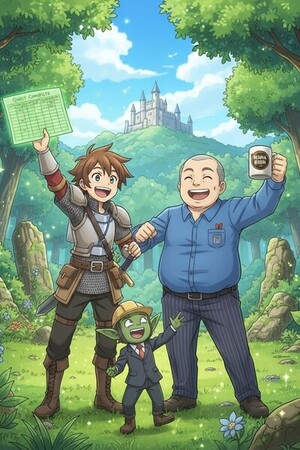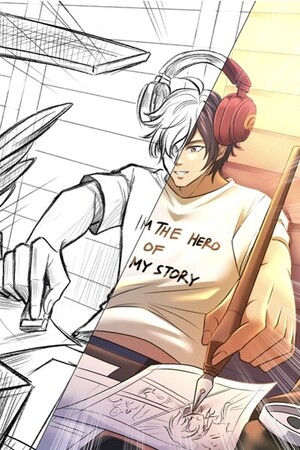Chapter 14:
Mistaken Identity?
Earthly Solutions
As we approached the entrance to Brightforge Smithy, Mr. Tanaka was reviewing his prepared talking points with the methodical precision of someone who had learned never to enter a business meeting unprepared.
"Strategic partnership proposal," he murmured, consulting his notes. "Standardized product specifications, volume pricing agreements, quality assurance protocols, and integrated inventory management systems."
"Remember," I added, "we want to emphasize the mutual benefits—we provide him with steady business and detailed market analysis, he provides our clients with consistent, high-quality equipment at predictable prices."
"Exactly. This should be a straightforward value proposition for any rational business owner."
We stepped into the smithy, and I was immediately struck by the scale and sophistication of the operation. Multiple forges were arranged in a systematic workflow pattern, with raw materials organized by type and quality grade. Tools were arranged with the kind of precision that spoke to someone who understood that efficiency meant keeping everything exactly where it needed to be.
But what caught my attention immediately was the massive figure working at the central forge, a man who had to be at least six... no, seven feet tall, with the kind of heavily muscled build that suggested he could probably bend steel bars with his bare hands. He was wearing a leather apron that had clearly seen extensive use, and his arms were easily the size of tree trunks.
This, I thought, is exactly what you'd expect from a legendary master blacksmith.
"That must be Mr. Brightforge ," Mr. Tanaka said quietly, consulting his notes. "The size and obvious physical strength would be consistent with someone capable of the kind of intensive metalworking that produces legendary-quality equipment."
I nodded, noting the way the large man moved with the confident precision of someone who had spent years perfecting his craft. Every motion was economical and purposeful, no wasted energy, no unnecessary movements. This was clearly someone who took his profession very seriously.
"Should we introduce ourselves?" I asked.
"Absolutely. Professional courtesy suggests we announce our presence rather than simply observing her work."
We approached the central forge where the impressive figure was working on what appeared to be a complex piece of armor. The attention to detail was remarkable, every surface was being carefully shaped and refined with the kind of meticulous care that suggested this was someone who refused to accept anything less than perfection.
"Excuse me," Mr. Tanaka called out in his most professional voice. "Mr. Brightforge?"
The large man looked up, and I was struck by his expression—not the confident, focused look I'd expected, but something closer to confusion. He glanced around the smithy as if he was looking for someone else.
"Mr. Brightforge," I continued, bowing. "I am honored to be in your presence. We're from Earthly Solutions LLC, a financial consulting firm. We were hoping to discuss a potential business partnership that could benefit both our organizations."
The confused expression deepened. The man looked back and forth between us, then around the smithy again, as if he was trying to solve a puzzle that didn't quite make sense.
"We've heard incredible things about your work," Mr. Tanaka continued. "The quality, the reliability, the exceptional craftsmanship… everyone in the adventuring community speaks of your equipment with genuine reverence."
Still no response, just that same puzzled expression.
"We believe," I added, "that your commitment to excellence and precision would align perfectly with our approach to systematic optimization and quality assurance protocols."
The large man blinked several times, opened his mouth as if to say something, then closed it again. He was clearly trying to process what we were saying, but something wasn't connecting.
"Are you... are you looking for someone?" he finally asked, his voice much higher and more uncertain than I'd expected from someone of his imposing physical presence.
"We're looking for Mr. Brightforge ," Mr. Tanaka said. "The master blacksmith whose reputation for exceptional work has made him the most sought-after equipment supplier in the region."
"Oh," the man said, his confusion beginning to resolve into something that looked almost like relief. "OH. You're looking for-”
"Your legendary skill with metallurgy," I continued, not wanting to interrupt what appeared to be his thought process, "combined with our expertise in financial optimization and supply chain management, could revolutionize equipment procurement for the entire adventuring economy."
The man's eyes were getting wider with each word we spoke. He kept glancing toward the back of the smithy, as if he was expecting someone to emerge and explain what was happening.
"We understand," Mr. Tanaka said, pulling out his briefcase and beginning to extract what appeared to be a comprehensive business proposal, "that someone with your level of skill and reputation would naturally be cautious about new business relationships. But we believe our proposal offers significant advantages for both parties."
"Advantages?" the man repeated weakly.
"Guaranteed volume commitments, standardized pricing structures, and detailed market analysis that would allow you to optimize your production scheduling and inventory management." Mr. Tanaka was hitting his stride now, his enthusiasm for systematic business planning overriding any awareness that his audience seemed less than fully engaged.
"We're particularly impressed," I added, "by the obvious precision and attention to detail evident in your workshop organization. The systematic arrangement of tools and materials suggests someone who understands that quality results require quality processes."
"Quality processes," the man echoed, sounding like he was trying out unfamiliar words.
"Yes!" Mr. Tanaka said, apparently interpreting this as genuine interest. "Our analysis indicates that your approach to metallurgical excellence could serve as a model for standardized production methodologies that would benefit the entire crafting community."
I was beginning to notice that something felt off about this conversation, but I couldn't quite identify what it was. The man was clearly listening to what we were saying, but his responses seemed oddly disconnected from our presentation.
"Mr. Brightforge," I said, trying a different approach, "perhaps you could tell us about your current production capacity and quality control procedures? We'd love to understand how you've achieved such consistent results."
"Production capacity," he repeated, that same uncertain tone.
"Yes," Mr. Tanaka said eagerly. "Daily output rates, material utilization efficiency, quality assurance protocols; The systematic processes that enable you to deliver such exceptional results on a consistent basis."
The man looked around the smithy again, as if the tools and equipment might provide some guidance for how to respond to our questions.
"I... uh... forge things?" he offered hesitantly.
Mr. Tanaka nodded enthusiastically. "Indeed! And we're hoping to help you forge even more efficiently through strategic business partnership and operational optimization!"
"The beauty of your work," I added, "is how you've combined traditional craftsmanship with what's clearly a very sophisticated understanding of metallurgical science. The precision evident in your equipment suggests someone who approaches their craft with both artistic vision and systematic methodology."
"Artistic vision," the man said, his voice taking on a slightly desperate quality. "Systematic methodology."
"We knew you'd understand," Mr. Tanaka said with satisfaction. "Someone with your level of professional excellence would naturally appreciate the value of strategic planning and operational efficiency."
I was becoming increasingly aware that this conversation was not proceeding as smoothly as I'd expected. While the man was clearly trying to engage with our presentation, something about his responses suggested that either we were missing some important context, or our assumptions about the situation weren't entirely accurate.
But Mr. Tanaka was fully committed to his business development presentation at this point, and I didn't want to interrupt his momentum when we were finally talking to the person who could potentially solve our supply chain standardization problems.
"Mr. Brightforge," Mr. Tanaka continued, "what would you say is your current lead time for standard equipment orders? We're hoping to establish predictable delivery schedules that would allow our clients to plan their equipment replacement cycles more effectively."
The man stared at him for a long moment, then looked around the smithy one more time, as if hoping that someone would appear to rescue him from this increasingly surreal conversation.
"Lead time," he said weakly. "For... equipment orders."
"Nothing too complicated initially," I assured him. "Basic swords, armor components, standard adventuring gear; any items that could be produced using established specifications and predictable timelines."
"Basic… swords…" he repeated, his voice now carrying a note of what I was beginning to recognize as barely suppressed panic.
But before either of us could continue our presentation, a new voice cut through the conversation with the kind of crisp authority that immediately commanded attention.
"Marcus, what in the seven hells are you doing?"




Please sign in to leave a comment.